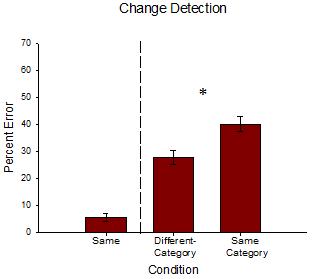Change Deafness
![]()
Change Deafness
![]()
The basic paradigm involves playing a group of sounds (usually, 4 or 5 at a time) for one second, interrupting the sound for 350 msec, and then playing either exactly the same set of sounds or replacing one of the sounds with a different sound. Here is an example of what a trial sounds like.
Our experiments have shown that even when people are good at reporting whether a given sound had been present, they are rather poor at noticing a change in the group of sounds. Among the questions we have examined in this area are:(1) Does change deafness decrease if the change is large, in terms of the acoustic difference between the replaced sound and the sound that replaced it?and(2) Are listeners less likely to notice a change if the object that disappears is replaced by another object from the same semantic category (e.g., one kind of phone ringing being replaced by a different kind of phone ringing), even if the acoustic difference is controlled for?
![]()
These are the sounds that we used in the experiment
Bell A Bell B
Bird A Bird B
Chicken A Chicken B
Chimes A Chimes B
Clap A Clap B
Dog A Dog B
Music Box A Music Box B
Phone A Phone B
Ship A Ship B
Train A Train B
Trumpet A Trumpet B
(1) Graph of f0/Harmonicity distribution of sounds, with 0, 1, or 2-feature changes
EXAMPLES OF 0-feature vs 2-feature change
DATA showing increased change deafness for 0 vs 2 feature change
(2) Graph of same-category vs different-category trial types
DATA showing semantic effect

![]()